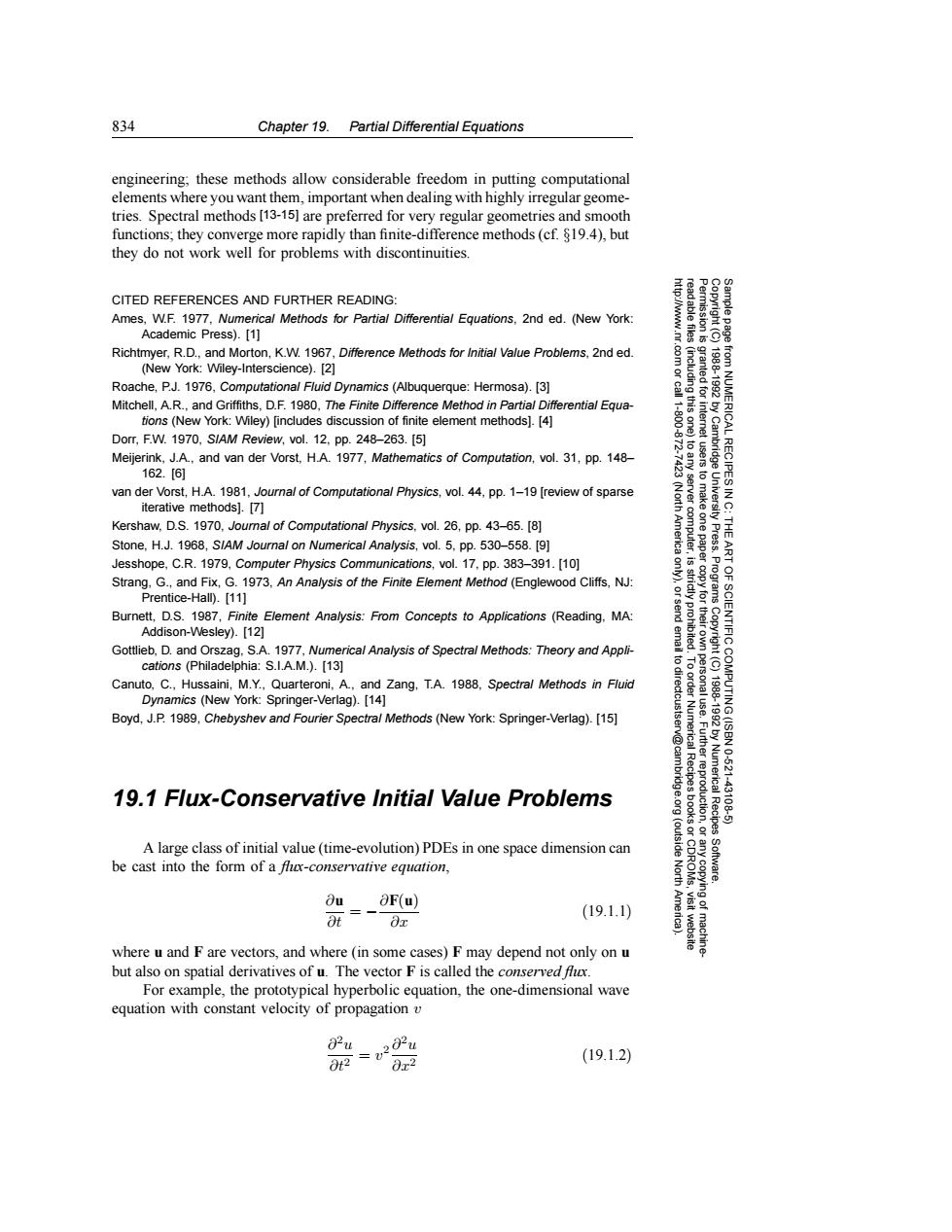正在加载图片...

834 Chapter 19.Partial Differential Equations engineering;these methods allow considerable freedom in putting computational elements where you want them,important when dealing with highly irregular geome- tries.Spectral methods [13-15]are preferred for very regular geometries and smooth functions;they converge more rapidly than finite-difference methods(cf.$19.4),but they do not work well for problems with discontinuities. CITED REFERENCES AND FURTHER READING: Ames,W.F.1977,Numerical Methods for Partial Differential Equations,2nd ed.(New York: Academic Press).[1] Richtmyer,R.D.,and Morton,K.W.1967,Difference Methods for Initial Value Problems,2nd ed. (New York:Wiley-Interscience).[2] Roache,P.J.1976,Computational Fluid Dynamics(Albuquerque:Hermosa).[3] Mitchell,A.R.,and Griffiths,D.F.1980,The Finite Difference Method in Partial Differential Equa- tions (New York:Wiley)[includes discussion of finite element methods].[4] Dorr,F.W.1970,S/AM Review,vol.12,pp.248-263.[5] Meijerink,J.A..and van der Vorst,H.A.1977,Mathematics of Computation,vol.31,pp.148- 162.[6] RECIPES van der Vorst,H.A.1981,Journal of Computational Physics,vol.44,pp.1-19 [review of sparse iterative methods].[7] 9 Kershaw.D.S.1970,Journal of Computational Physics,vol.26,pp.43-65.[8] Stone,H.J.1968,SIAM Journal on Numerical Analysis,vol.5,pp.530-558.[9] Jesshope,C.R.1979,Computer Physics Communications,vol.17,pp.383-391.[10] Strang.G..and Fix,G.1973.An Analysis of the Finite Element Method(Englewood Cliffs,NJ: Prentice-Hall).[11] 是 Burnett,D.S.1987,Finite Element Analysis:From Concepts to Applications (Reading,MA: Addison-Wesley).[12] IENTIFIC Gottlieb,D.and Orszag.S.A.1977,Numerical Analysis of Spectral Methods:Theory and Appli- cations(Philadelphia:S.I.A.M.).[13] 6 Canuto,C.,Hussaini,M.Y.,Quarteroni,A,and Zang,T.A.1988,Spectra/Methods in Fluid Dynamics (New York:Springer-Verlag).[14] Boyd,J.P.1989,Chebyshev and Fourier Spectral Methods(New York:Springer-Verlag).[15] Numerica 10.621 19.1 Flux-Conservative Initial Value Problems 4312 Recipes A large class of initial value(time-evolution)PDEs in one space dimension can (outside be cast into the form of a flx-conservative equation, North Ou OF(u) dt=- (19.1.1) Ox where u and F are vectors,and where(in some cases)F may depend not only on u but also on spatial derivatives of u.The vector F is called the conserved flux. For example,the prototypical hyperbolic equation,the one-dimensional wave equation with constant velocity of propagation v 03=v202u 82u (19.1.2) 0x2834 Chapter 19. Partial Differential Equations Permission is granted for internet users to make one paper copy for their own personal use. Further reproduction, or any copyin Copyright (C) 1988-1992 by Cambridge University Press. Programs Copyright (C) 1988-1992 by Numerical Recipes Software. Sample page from NUMERICAL RECIPES IN C: THE ART OF SCIENTIFIC COMPUTING (ISBN 0-521-43108-5) g of machinereadable files (including this one) to any server computer, is strictly prohibited. To order Numerical Recipes books or CDROMs, visit website http://www.nr.com or call 1-800-872-7423 (North America only), or send email to directcustserv@cambridge.org (outside North America). engineering; these methods allow considerable freedom in putting computational elements where you want them, important when dealing with highly irregular geometries. Spectral methods [13-15] are preferred for very regular geometries and smooth functions; they converge more rapidly than finite-difference methods (cf. §19.4), but they do not work well for problems with discontinuities. CITED REFERENCES AND FURTHER READING: Ames, W.F. 1977, Numerical Methods for Partial Differential Equations, 2nd ed. (New York: Academic Press). [1] Richtmyer, R.D., and Morton, K.W. 1967, Difference Methods for Initial Value Problems, 2nd ed. (New York: Wiley-Interscience). [2] Roache, P.J. 1976, Computational Fluid Dynamics (Albuquerque: Hermosa). [3] Mitchell, A.R., and Griffiths, D.F. 1980, The Finite Difference Method in Partial Differential Equations (New York: Wiley) [includes discussion of finite element methods]. [4] Dorr, F.W. 1970, SIAM Review, vol. 12, pp. 248–263. [5] Meijerink, J.A., and van der Vorst, H.A. 1977, Mathematics of Computation, vol. 31, pp. 148– 162. [6] van der Vorst, H.A. 1981, Journal of Computational Physics, vol. 44, pp. 1–19 [review of sparse iterative methods]. [7] Kershaw, D.S. 1970, Journal of Computational Physics, vol. 26, pp. 43–65. [8] Stone, H.J. 1968, SIAM Journal on Numerical Analysis, vol. 5, pp. 530–558. [9] Jesshope, C.R. 1979, Computer Physics Communications, vol. 17, pp. 383–391. [10] Strang, G., and Fix, G. 1973, An Analysis of the Finite Element Method (Englewood Cliffs, NJ: Prentice-Hall). [11] Burnett, D.S. 1987, Finite Element Analysis: From Concepts to Applications (Reading, MA: Addison-Wesley). [12] Gottlieb, D. and Orszag, S.A. 1977, Numerical Analysis of Spectral Methods: Theory and Applications (Philadelphia: S.I.A.M.). [13] Canuto, C., Hussaini, M.Y., Quarteroni, A., and Zang, T.A. 1988, Spectral Methods in Fluid Dynamics (New York: Springer-Verlag). [14] Boyd, J.P. 1989, Chebyshev and Fourier Spectral Methods (New York: Springer-Verlag). [15] 19.1 Flux-Conservative Initial Value Problems A large class of initial value (time-evolution) PDEs in one space dimension can be cast into the form of a flux-conservative equation, ∂u ∂t = −∂F(u) ∂x (19.1.1) where u and F are vectors, and where (in some cases) F may depend not only on u but also on spatial derivatives of u. The vector F is called the conserved flux. For example, the prototypical hyperbolic equation, the one-dimensional wave equation with constant velocity of propagation v ∂2u ∂t2 = v2 ∂2u ∂x2 (19.1.2)